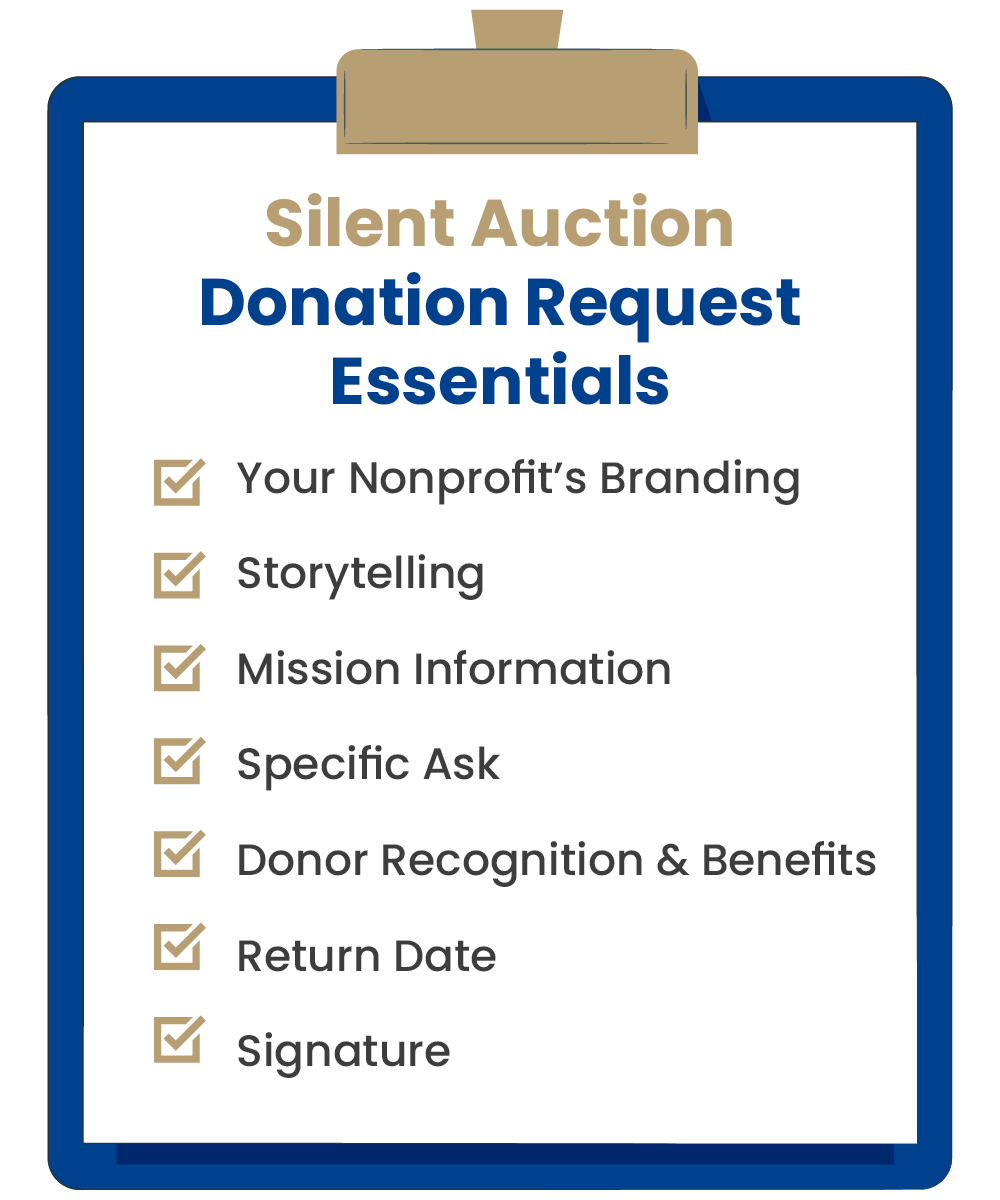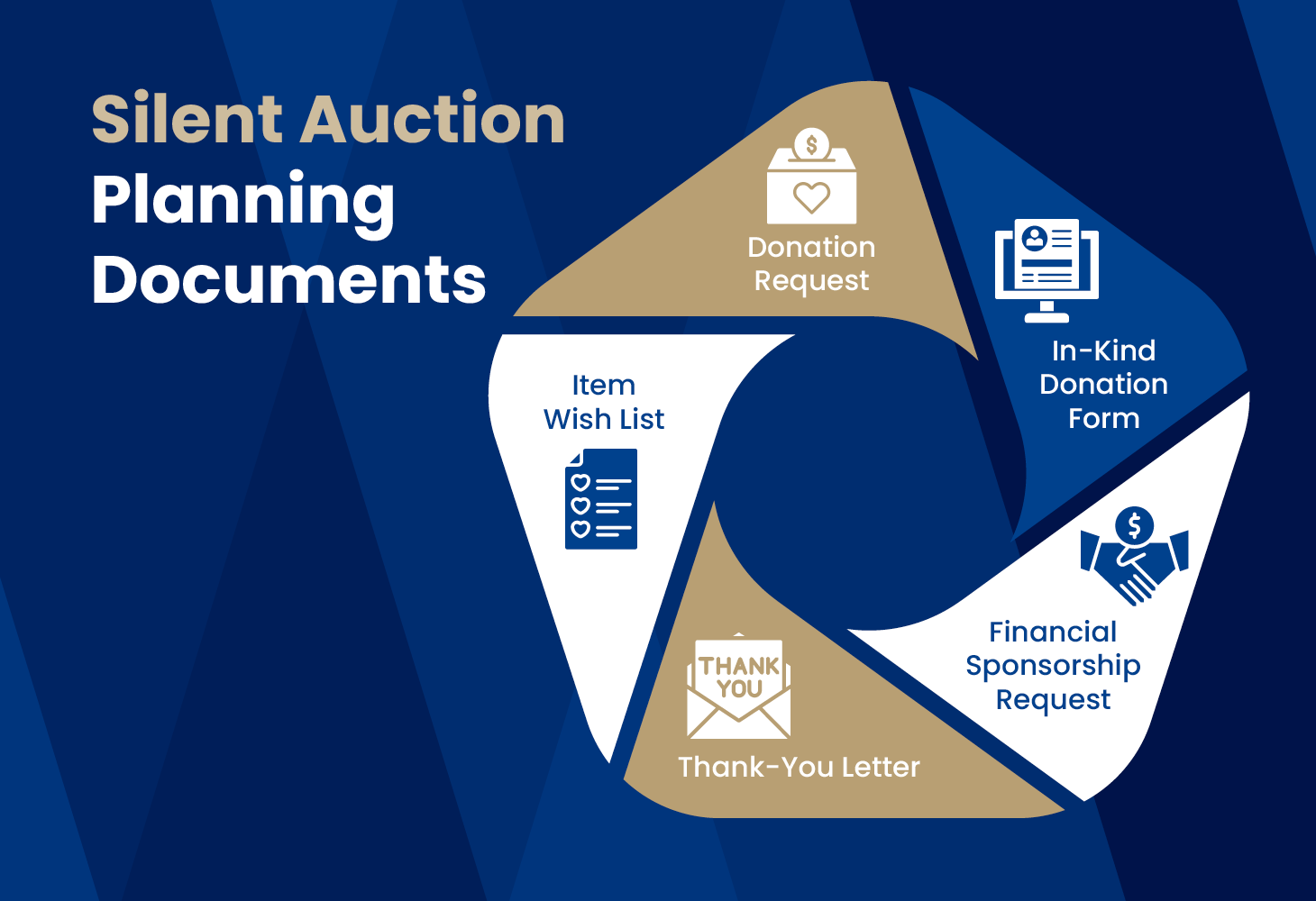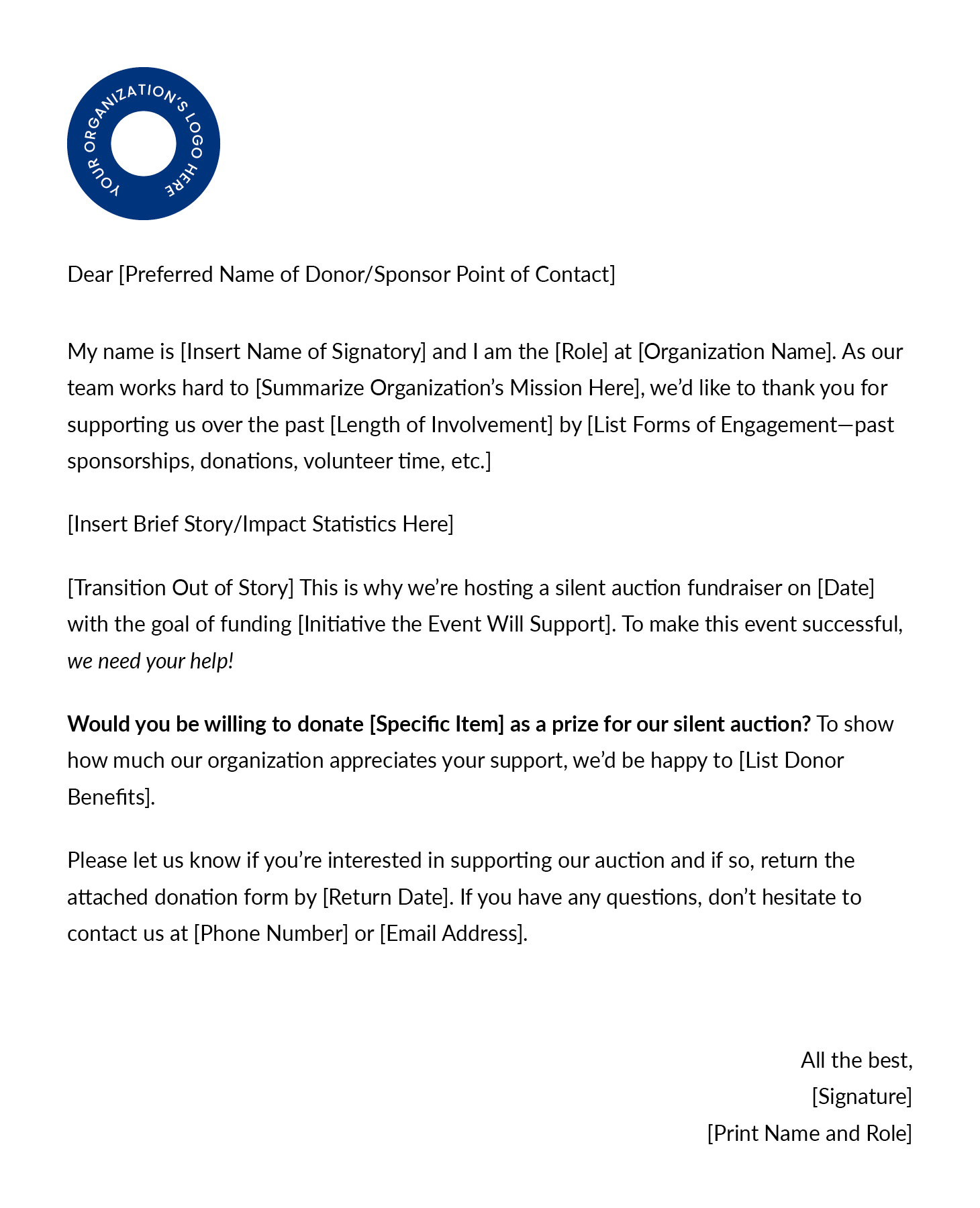Procuring high-quality, appealing silent auction items is essential for engaging supporters through your nonprofit’s event and reaching your fundraising goals. However, it’s also important to keep upfront event costs low to maximize the amount of funding that can go toward your organization’s mission afterwards.
To strike a balance between these considerations, try to procure your silent auction items at the lowest possible cost—or for no cost at all by requesting in-kind donations from individuals and businesses. In this guide, you’ll learn all you need to know to create a compelling silent auction donation request for any contributor, including:
- What is a silent auction donation request?
- Auction Donation Request Essentials
- Other Important Silent Auction Forms
- Silent Auction Donation Request Template
Let’s get started by defining what a silent auction donation request is and discussing how to format it.
What is a silent auction donation request?
A silent auction donation request is a solicitation made by a nonprofit with the goal of receiving in-kind contributions of goods, services, or experiences to use as prizes. Your organization may send these requests to individuals, businesses, or other nonprofits, depending on what items you’re looking for.
While the term “silent auction donation request” typically refers to a written document, you can solicit in-kind donations for your auction in several ways:
- In-person meetings
- Phone calls or video chats
- Direct mail
If possible, meet with potential donors in person or via video chat so you can talk to them directly, especially if you’re asking for a high-value item. Use your written donation request to guide the conversation, then send the prospect a copy of the letter after the meeting so they can reference it as they decide whether to contribute. If face-to-face meetings aren’t feasible with some prospects, your donation request letter should be able to stand alone so you can ask for the item via email or direct mail.
Auction Donation Request Essentials
Every nonprofit and prospective donor is unique, so your silent auction donation requests will be most effective if they’re tailored to your organization and audience. However, there are a few elements you should include no matter what, which we’ll walk through in the following sections.
Your Nonprofit’s Branding
Branding makes your organization recognizable and memorable for potential donors, helping to “sell” them on supporting your mission. When formatting your silent auction donation requests, include the following brand elements in your template:
- Logo. Add your logo to the letterhead so the reader can immediately identify the request as coming from your organization.
- Color scheme. Design your letterhead in your nonprofit’s brand colors to draw the reader in visually, ensuring adequate contrast between the background color and any text you include.
- Typography. Use the same font throughout the body of the request and ensure it’s easy to read either on paper or on a screen, depending on how you’ll give the letter to the donor.
- Messaging. Branding also extends to the language you use to communicate about your mission, so keep your word choice, tone, and mechanics (e.g., whether you use the Oxford comma) consistent as you write.
Consistently branding your donation requests gives them a professional look and feel, which adds to their credibility and makes donors more likely to consider contributing auction items.
Storytelling
At the beginning of your letter, hook the reader by telling a true story about your nonprofit’s work. Storytelling demonstrates your organization’s past impact, engages donors’ emotions, and inspires them to support you in your upcoming efforts.
The most compelling nonprofit stories typically focus on how the organization improved the life of one of its beneficiaries. For example, an animal shelter might tell the story of a rescue cat that found its forever home through the organization. Remember to obtain consent from any human subjects (or their guardians if they’re underage) before using their names or photos in your donation requests.
You may also include relevant images and statistics in your donation request to ground your story in reality. The animal shelter in our previous example could include before-and-after pictures of the cat to show how happy and healthy it is in its new home compared to when the shelter took it in. Additionally, they might report that this cat was one of 200 adopted from the organization last year to demonstrate their impact.
Mission Information
If your nonprofit’s mission wasn’t made crystal clear to the donor through your story, it should be once they read this section. Begin by briefly describing your overall purpose, then mention how your auction fits into funding a specific aspect of that mission.
It can be helpful to mention a few of your organization’s core values in this section as well, especially when requesting auction item donations from corporate sponsors. The most effective partnerships between nonprofits and businesses are built on shared values, so establish them early on to catch prospective donors’ attention.
Additionally, if the potential donor has engaged with your nonprofit in the past, thank them for their specific contributions to show you value them before asking for their support again.
Specific Ask
The most important part of any fundraising solicitation is the call to action. For silent auction donation requests, the best calls to action identify a particular item you want the donor to provide. This ask should align with the individual supporter’s interests or the goods and services the corporate sponsor offers, as well as the prize value you think they’d be willing to contribute.
Research and segment potential auction item donors to ensure you ask the right individuals or businesses for the right prizes. However, when you approach a donor, have a few alternatives in mind in case they turn down your initial request but still seem interested in supporting your organization.
Donor Recognition & Benefits
Particularly with corporate sponsors, prospective auction item donors often want to know what is in it for them if they contribute. Spell out the perks they can expect in return, such as:
- Shoutouts in your event marketing materials
- Features on your bid sheets or signage at the event venue
- Opportunities for business representatives to speak at your auction
The forms of recognition you mention in your donation request are in addition to the personalized thank-you notes you’ll send to each auction item donor (those should go without saying).
Return Date
If you don’t give donors a deadline to send you their contributions, you likely won’t get all of your items in time for your silent auction. Try to set the return date at least two months in advance of your event. That way, you’ll have some breathing room to follow up with unresponsive donors, price each item, design display sheets, and incorporate photos of the most valuable prizes into event marketing materials.
Signature
Lastly, ensure each silent auction donation request is signed by a senior individual at your nonprofit, such as your president, fundraising director, or board chair. Along with your branding, this signature adds to your letter’s credibility and persuasiveness.
Other Important Silent Auction Forms
While solid donation requests are essential to silent auction item procurement, they aren’t the only documents you’ll need to make this process go smoothly. Here are a few other forms you should have on hand as you get started:
- In-kind donation form. Leave this form behind with your donation request so that when a donor is ready to contribute an auction item, they have the paperwork ready to do so. It should include spaces to fill in the donor’s contact information, the item’s description and estimated value, and tax deduction information for the gift.
- Financial sponsorship request. Some sponsors might prefer to provide direct financial contributions to your event rather than donating auction items. This document should outline the levels of sponsorships available, their prices, and the benefits associated with each tier so donors can choose how much support they’re able and willing to give.
- Thank-you letter. Prompt appreciation is essential to show auction item donors that you value their support and want to develop a lasting relationship with them. Before you start soliciting item donations, create a thank-you letter template that you can customize for each donor and send out within 48 hours of their contribution.
- Item wish list. At the beginning of the procurement process, get your team together and brainstorm a list of items you’d like to feature in your auction. This document will serve as a reference for the specific asks you’ll include in each donation request—and for suggesting alternatives after an initial rejection.
Compile all of these forms into a digital folder to share with your event planning staff and item procurement committee. This way, whenever a team member needs to customize a form for a donation ask they’re planning, they can quickly make copies of each document and edit them as needed for their recipient.
Silent Auction Donation Request Template
Now that you know what elements into a successful silent auction donation request and what other forms you need to create to go with it, it’s time to start writing your own letters! To help you get started, we’ve created this handy template you can customize for your nonprofit:
Other Ways to Secure Auction Items
Even with a top-quality silent auction donation request letter, there will probably be some items on your wishlist that your nonprofit can’t easily secure via in-kind donations. This doesn’t mean you should take these prizes off the list, though, especially because the kinds of items that are trickiest to secure are often the most appealing and valuable prizes you could feature!
If you can’t get a business to contribute an item for free, try to secure it at a reduced price. Especially when it comes to ticketed experiences like concerts, athletic events, or theme park entry, many companies offer nonprofit discounts. However, these aren’t always well-advertised and may require some negotiation, so put a member of your procurement committee in charge of calling venues to discuss discounts.
Travel-related items tend to be best-sellers at auctions, but trying to secure disparate parts of a vacation package (transportation, accommodations, activities, etc.) via donations or discounts is time-consuming and frequently leads to dead ends. Instead, consider procuring these items through a consignment travel provider like Winspire.
Winspire’s vacation packages (known as Experiences) are specifically designed for nonprofit fundraising and are risk-free since you only pay for what you sell at your event. Simply add the Experiences you think will appeal most to your auction participants to your Suitcase (cart) and offer them at your event—we’ll take care of the rest! After your event, every dollar you raise above the Nonprofit Cost (list price) will go directly to your mission.
Wrapping Up: Additional Resources on Requesting Auction Item Donations
A well-written silent auction donation request is the key to securing many engaging items at no cost to your nonprofit, maximizing your event fundraising potential. After you’ve drafted your first donation request letter, ask a few people at your organization to read over it and provide feedback so you can hand off the best possible final version to your procurement committee and lay the foundation for successful asks.
To learn more about securing donated auction items, check out these resources:
- What Is an In-Kind Donation? The Complete Nonprofit Guide. Explore the entire world of in-kind donations, including their other use cases, ways to overcome their common pain points, solicitation tips, and more.
- Donor Stewardship: How to Foster Lasting Relationships. Discover best practices for recognizing and building relationships with everyone who contributes to your auction’s success—item donors, financial sponsors, participants, and volunteers.
- Top 10 Types of Charity Auction Items + Tips to Procure Them. Jumpstart your auction item wishlist brainstorming by reviewing the most popular categories of charity auction prizes.

![The title of the post: “How to Craft a Silent Auction Donation Request [+ Template].”](https://www.winspireme.com/wp-content/uploads/2024/01/silent-auction-donation-request_feature-2.png)





